Over a series of posts, we have followed the emergence of the science of botany out of the Renaissance humanist physicians’ endeavours to integrate materia medica, the study of simples or medical herbs, into the Renaissance university teaching curriculum. By the end of the sixteenth century the books on plants that were being published were definitely works of botany and no longer works of medicine. However, one of the books that helped launch the gradual rise of botany during the century, Pliny’s more than somewhat disputed[1]Naturalis historia was actually encyclopaedic in its scope covering much more than just the flora of antiquity, which only made up sixteen of the thirty-seven books. Four of the other books were devoted to the fauna of antiquity, covering mammals, snakes, marine animals, birds, and insects. Aristotle had also written two books on the fauna his De Partibus Animalium and his Historia Animalium as well as the De Generatione Animalium, which is attributed to him. All three books were well known and published in the Renaissance. Albertus Magnus (c.1200–1280), who translated the Aristotelian corpus in the thirteenth century, also wrote a De animalibus, which was known and read in the Renaissance.
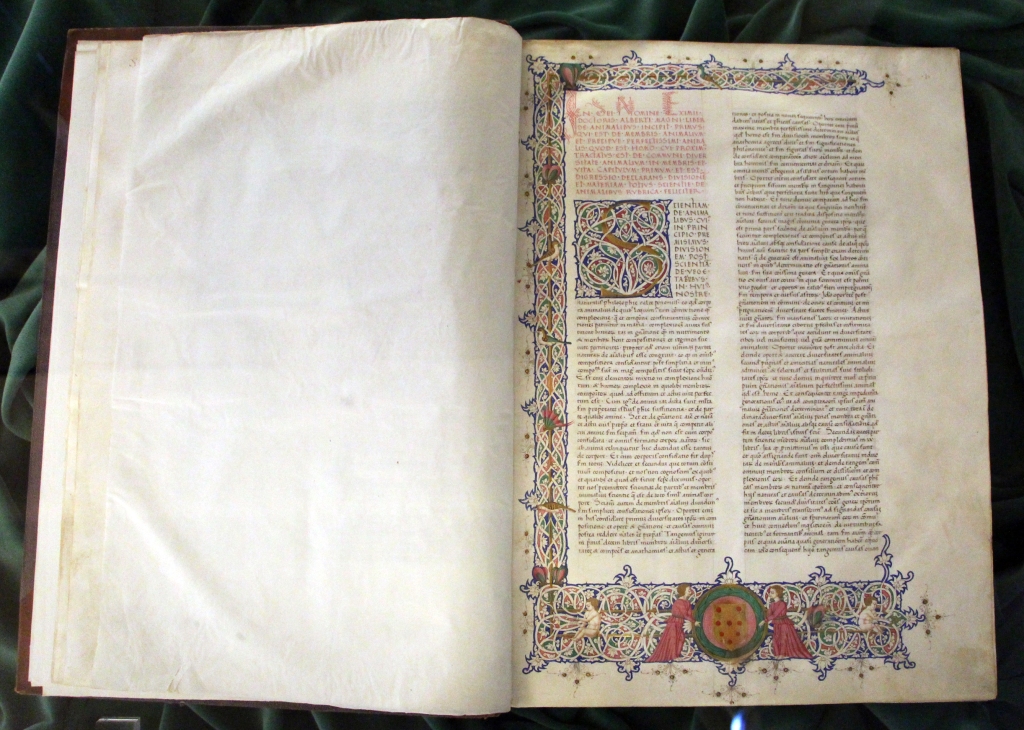
All of this raises the question, was there development of zoology as a discipline during the sixteenth century similar to that of botany? The answer is both yes and no. A much smaller number of authors wrote books on the fauna and the development, at that time, progressed by no means as far as that of botany. However, as we will see two authors in particular stand out and they can and have been labelled the founders of modern zoology, they are the Swiss polymath Conrad Gesner (1516–1565) and the equally polymathic Italian natural historian Ulisse Aldrovandi (1522–1605). However, before we look at the work of these two intellectual giants, and it is not an exaggeration to call them that, we will first take a look at the others, who published on fauna in the period and, to begin, briefly discuss why the development of zoology lagged behind that of botany.
When you spell out the reasons why the development of zoology in the Renaissance lagged behind that of botany, they seem pretty obvious, but you first have to think about the problem. Whereas the ongoing botanist could and did send each other, seeds, bulbs, dried plants in the form of herbarium sheets, and even living plants carefully packaged in letters and packages with the post you can’t pop a rhinoceros in an envelope and send it to someone.
My example may seem more than somewhat ridiculous, but it refers to a real, notorious, historical occurrence. Perhaps the most well known of all Renaissance prints is Albrecht Dürer’s Rhinoceros, which we will meet again later. Dürer’s print is based on verbal descriptions of an Indian rhinoceros that was sent, by ship, as a gift to King Manuel I of Portugal in 1515. Manuel actually staged a combat between his rhinoceros and a young elephant to test Pliny’s account that elephants and rhinoceroses were enemies. The young elephant fled, and the rhinoceros was declared the winner. Manual decided to give his rhinoceros to the Medici Pope Leo X, and it embarked one again on a ship across the Mediterranean, but this time did not survive the journey dying in a shipwreck off the coast of Italy. Dürer’s print was based on a letter and sketch of the beast sent from Lisbon to Nürnberg. As we shall see, many of the early printed accounts of animals were based on verbal descriptions and sketches rather than actual encounters with the animals themselves. The animal studies of Renaissance artists like Dürer or Leonardo also played a role in stimulating interest in animals amongst the humanist scholars.
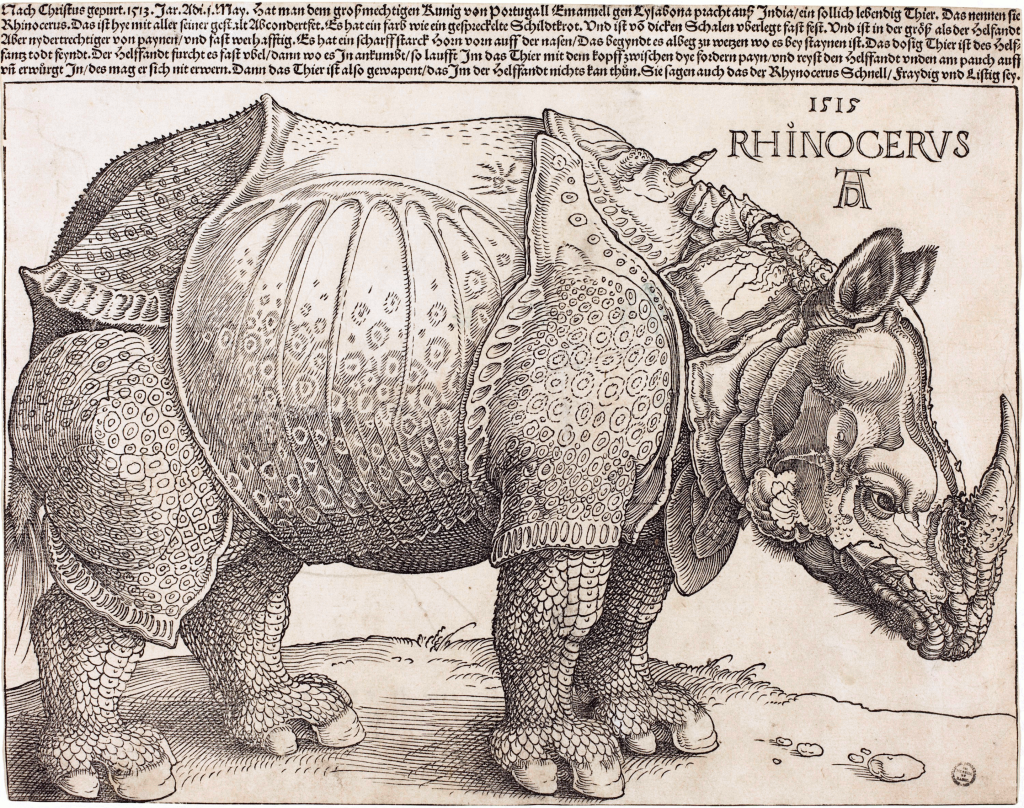
Another major problem is that if you go out on excursions or field trips to empirically study plants, the plants remain quietly where they are whilst you examine, sketch, or even dig them up to take them home with you. Most animals aren’t as accommodating. In fact, most wild animals will take to their heels and disappear when they hear humans approaching. Proto-zoologists were dependent on the second hand reports of hunters, field workers, or foresters of animals they didn’t get to observe themselves. Putting this all together, it is simply much more difficult to conduct empirical research on animals than on plants. It therefore comes as no surprise that the first zoological publications in the Renaissance were about fishes and birds, animals that humans eat and are thus more accessible to the researcher. It should be noted that in the Early Modern period people ate a much wider range of birds than we do today and that whales were also extensively eaten throughout Europe. In fact, the European whaling industry began in the Middle Ages because the Church classified them as fish, meaning they could be eaten on a Friday, a fast day when eating meat was forbidden.
Before turning to the early Renaissance zoologists, we will take a brief look at the medieval manuscripts of animals, the bestiaries. Unlike the medieval herbals, which served a practical medical function, the bestiaries served a philosophical or religious function. The natural histories and illustrations of the individual beasts were usually accompanied by a moral lesson. The animals served a symbolic function rather than a practical one. The illustrations were mostly copied from earlier ancient Greek sources, the earliest known example is the second century Greek work, the Physiologus, which draws on earlier authors such as Aristotle, Herodotus, Pliny, and others.
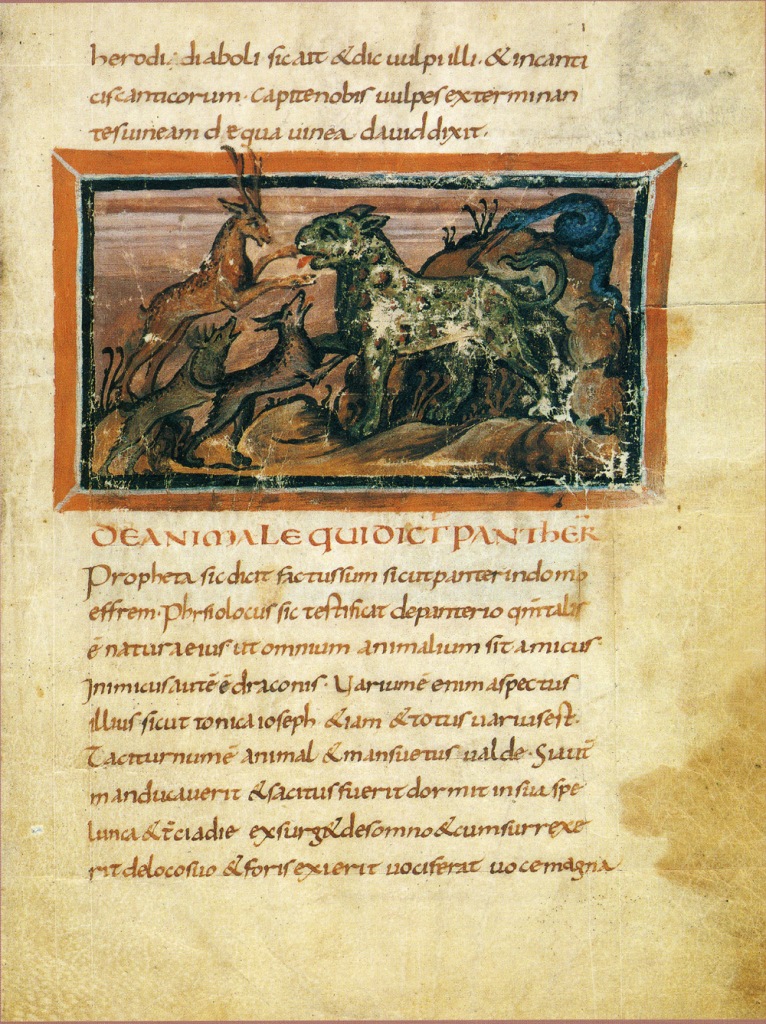
The genre was further developed by Isidore of Seville and Saint Ambroise, who added a religious dimension. Bestiaries were very popular in the High Middle Ages, but had little or no influence on the beginnings of zoology in the Renaissance, unlike the influence herbals had with plants.
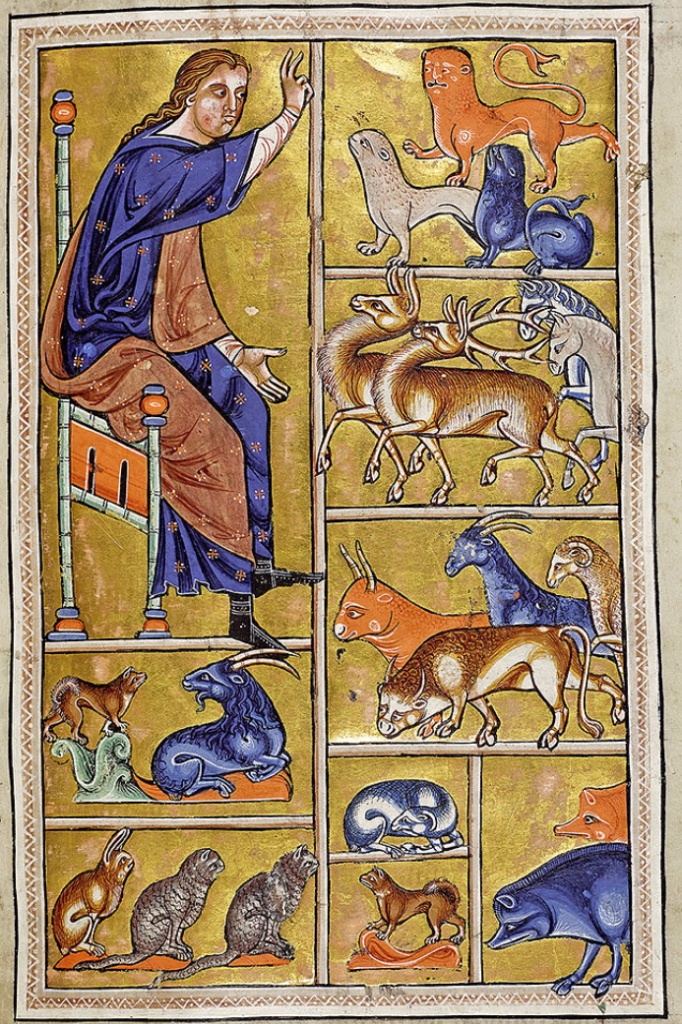
The earliest zoological text from the sixteenth century was published by the English naturalist William Turner (1509/10–1568), who, as we saw in the episode on herbals, was motivated by his travels and studies in Northern Italy. Before he began publishing his more famous herbal in 1551, he had already published Avium praecipuarum, quarum apud Plinium et Aristotelem mentio est, brevis et succincta historia (The Principal Birds of Aristotle and Pliny…), which not only discussed the birds to be found in the two authors from antiquity but contained descriptions of birds based on his own empirical observations.
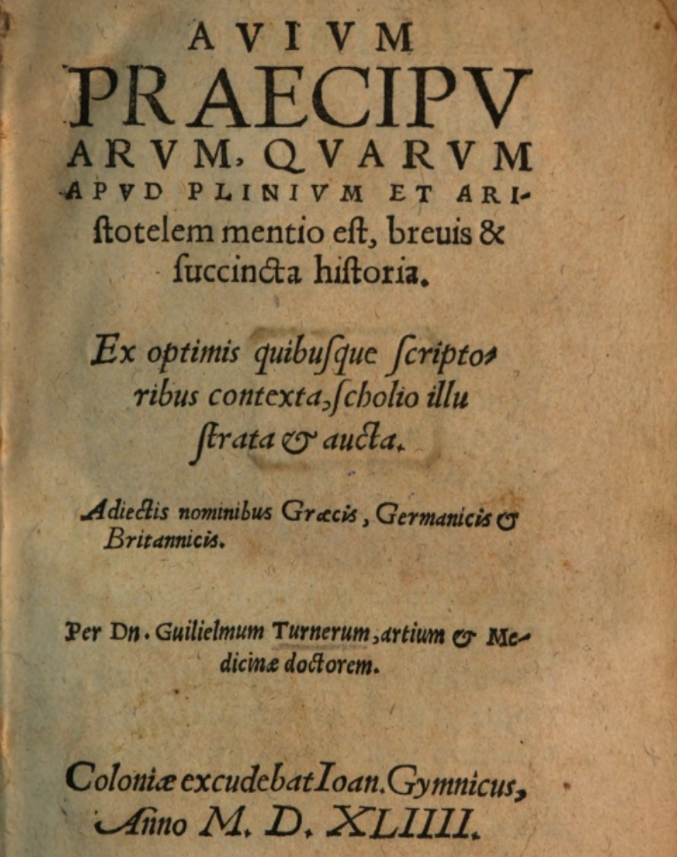
Much more extensive are the zoological works by the French traveller and naturalist, Pierre Belon (1517–1564).
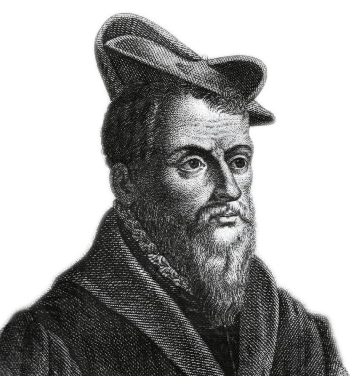
Little is known of his origins, but in the early 1530s he was apprenticed to the apothecary René des Prey. He entered the service of René du Bellay Bishop of Le Man (c. 1500–1546) in the second half of the 1530s, who permitted him to study medicine at the University of Wittenberg under Valerius Cordus (1515–1544).[2] He travelled through Germany with Cordus in 1542, continuing on through Flanders and England alone. He continued his studies in Paris, and then became apothecary to Cardinal François de Tournon (1489–1562) in whose service he undertook diplomatic journeys to Greece, Crete, Asia Minor, Egypt, Arabia, and Palestine between 1546 and 1549. An avid polymath he recorded everything he saw and experienced on his travels. During a Papal conclave, 1549–1550, he met up with Guillaume Rondelet (1507–1566), who would be appointed professor for medicine in Montpellier, and the Italian physician Hippolyte Salviani (1514–1572). Returning to Paris he began to sort his notes and publish his zoology texts. In 1557 he undertook another journey to Northern Italy, Savoy, the Dauphiné, and Auvergne. In 1558 he obtained his medical licence and began to practice medicine. He became a favourite of the Kings Henry II (1519–1559) and Charles IX (1550–1574). The latter providing him with lodgings in Château de Madrid in the Bois de Boulogne. His promising career was cut short when he was murdered in 1564.
Between 1551 and 1557 he wrote and published a series of books based on his travel observations. His first book was his L’histoire naturelle des estranges poissons marins, avec la vraie peincture & description du Daulphin, & de plusieurs autres de son espece. Observee par Pierre Belon du Mans published in Paris in 1551.
 100vw, 689px”></a><figcaption>L’histoire naturelle des estranges poissons marins A Paris :De l’imprimerie de Regnaud Chaudiere,1551. <a href=) http://www.biodiversitylibrary.org/item/26657 Source: Wikimedia Commons
http://www.biodiversitylibrary.org/item/26657 Source: Wikimedia CommonsThis is a description of the fish and cetaceans, such as dolphins and porpoises, that he had observed and dissected on his travels. Aristotelean in nature the work contained a classification system for marine fish, including both cetaceans and hippopotami under fishes, although he recognised that cetaceans had mammalian milk glands and were air breathing. Two years later he published a more general book on fish, his De aquatilibus. Libri duo Cum eiconibus ad vivam ipsorum effigiem, Quoad eius fieri potuit, expressis, also in Paris. This contained descriptions of 110 fish species and is a founding text of the discipline of ichthyology. A French edition De aquatilibus. Libri duo Cum eiconibus ad vivam ipsorum effigiem, Quoad eius fieri potuit, expressis was published in Paris in 1555.
In 1553 he also contributed to the botanical literature with his De arboribus Coniferis, Resiniferis aliisque semper virentibus…, a book on confers, pines and evergreen trees. It was published in both Latin and French in the same year. The same year saw the publication of his more general Les obsevations de plusieurs singularitez et choses memorables trouvées en Grèce, Asie, Judée, Egypte, Arabie et autres pays étrangèrsas well as a three-volume work on funerary customs in Antiquity. A revised edition of his Observations was published in 1555 and Clusius translated them into Latin for an international readership in 1559.
In 1555 he turned his attention to birds publishing his Histoire de la nature des oyseaux in Paris. It describes about 200, mostly European, birds. This book is particular notable for its comparison of the skeletons of a bird and a human, one of the earliest examples of comparative anatomy.
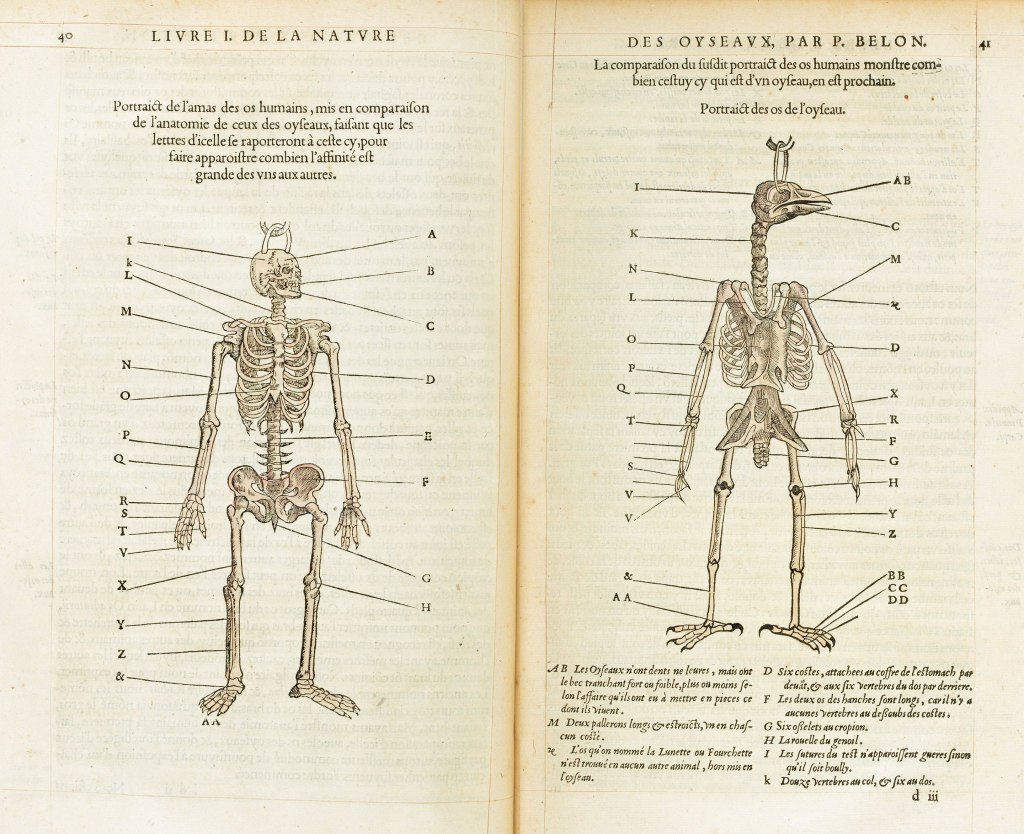
He rounded off this burst of publications with his Portraits d’oyseaux, animaux, serpens, herbes, arbres, hommes et femmes, d’Arabie et Egypte, in Paris in 1557.
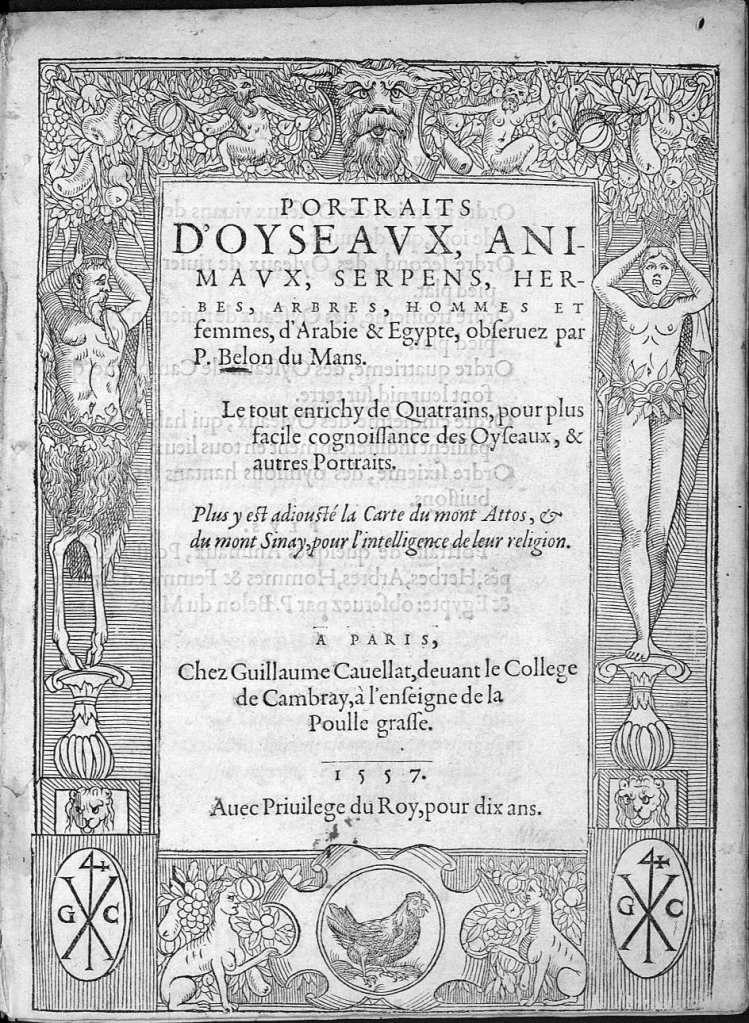
Much of the information in his books on both fishes and birds was obtained by investigating those that came to market in the towns that he visited. On his trip to England, he also met the Venetian humanist scholar and architect, Daniel Barbaro (1514–1570), Palladio’s patron, who had made many drawings of Adriatic fish.
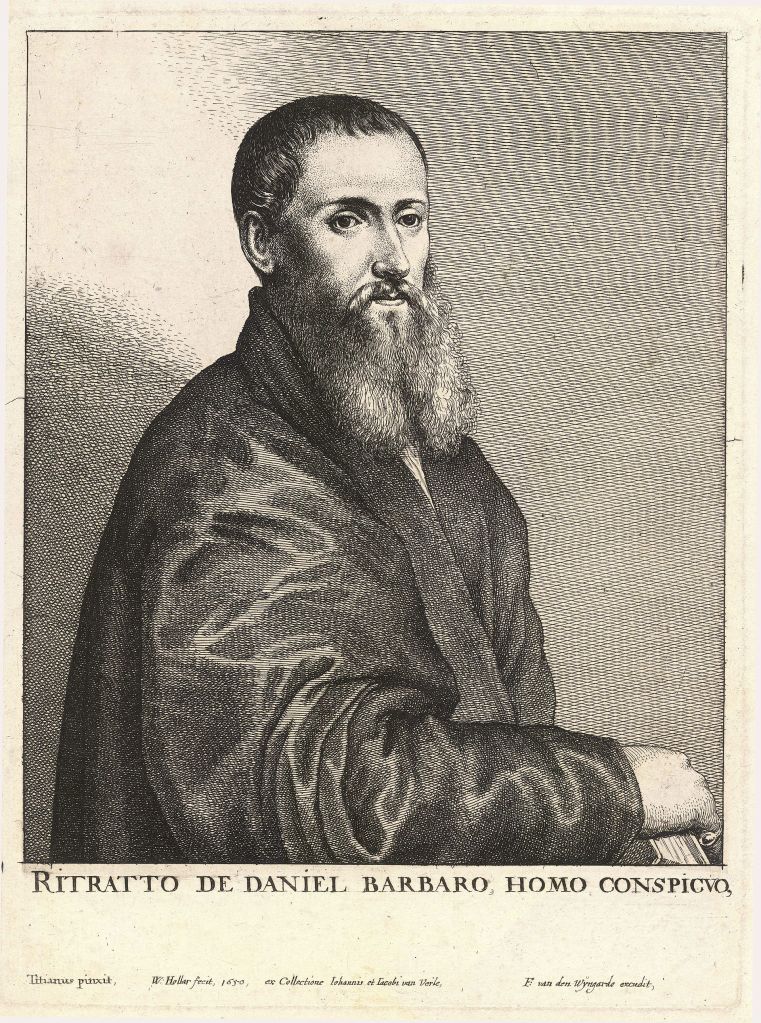
The Italian physician, humanist scholar, and naturalist Hippolyte Salviani (1514–1572), who as we saw above met Belon at the Papal conclave in 1549–1550, was the personal physician to the House of Farnese from 1550 till 1555 and taught at the University of Rome until 1568.
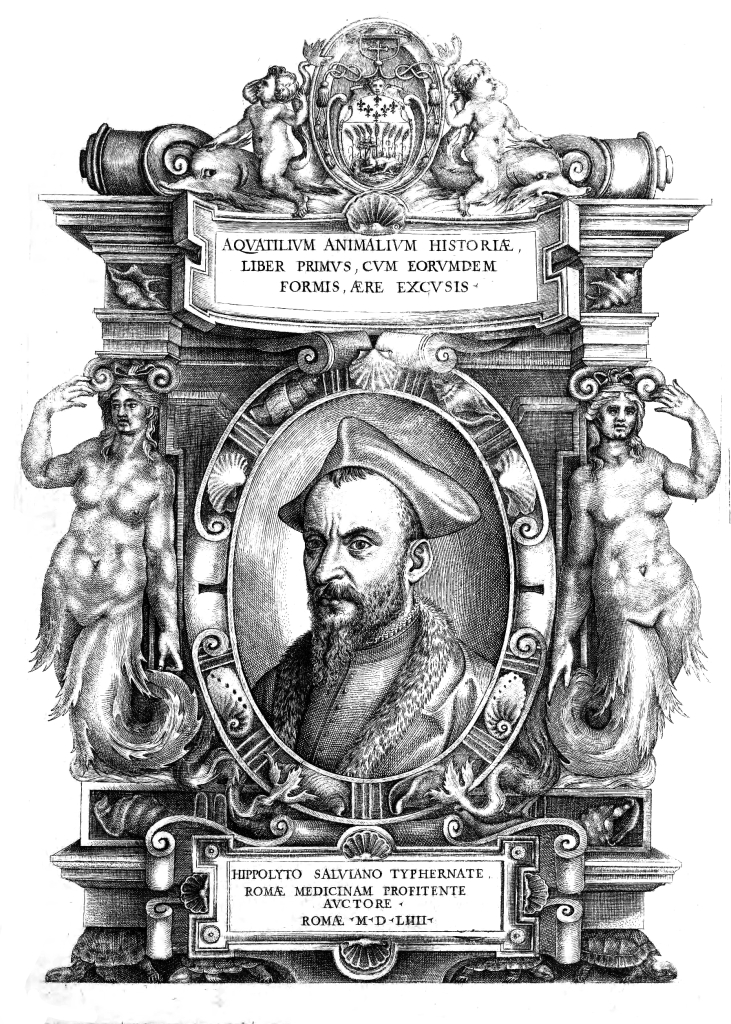
Like Belon he wrote and published a work on fish Aquatilium animalium historiae (1554-1558), which depicted about one hundred Mediterranean fish species and some molluscs. He was aware of the difference between cephalopods and fish. This work was based on his own empirical observations, and he was supported financially in his work by Cardinal Marcello Cervini (1501–1555), later Pope Marcellus II. The work was dedicated to Cervini’s successor Gian Carafa (1476–1559), Pope Paul IV. Like Belon most of his fish research was done with fish from the markets.
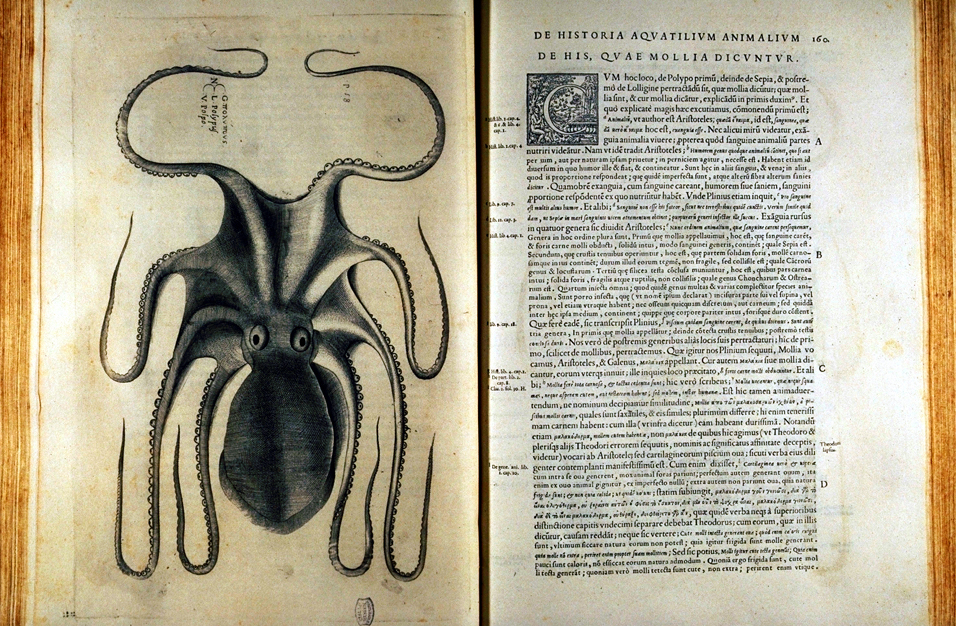
Guillaume Rondelet (1507–1566), who was also at that Papal conclave, went on to become professor for medicine at the University of Montpellier, where he taught several important natural historians including Charles de l’Écluse (Carolus Clusius) (1526–1609), Matthias de l’Obel (Matthias Lobelius) (1538–1616), Pierre Pena (c. 1530–c. 1600), Jacques Daléchamps (1513–1588), Jean Bauhin (1511–1582), and Felix Platter (1536–1614).
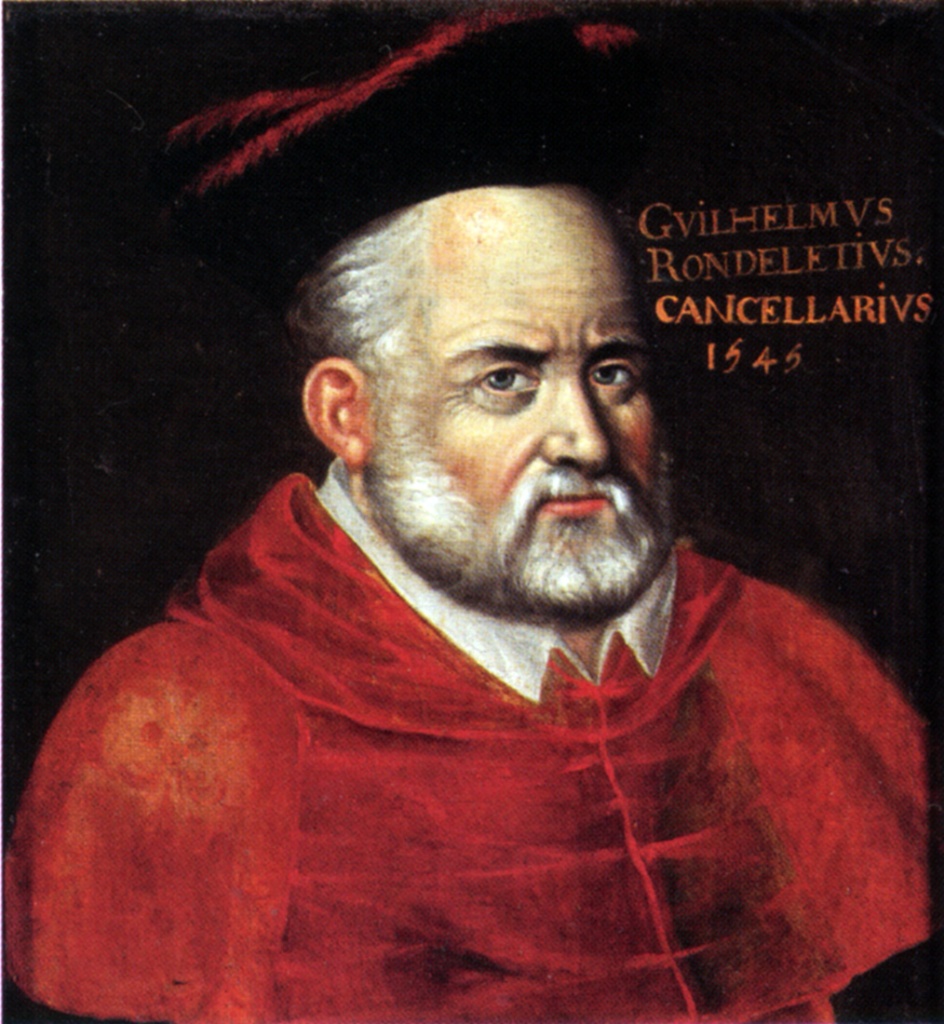
Although he was one of the greatest teachers of medicine and natural history in the sixteenth century, he published very little himself. However, like Belon and Salvini, he published a work on marine life, his Libri de piscibus marinis in quibus verae piscium effigies expressae sunt (Lyon, 1554).
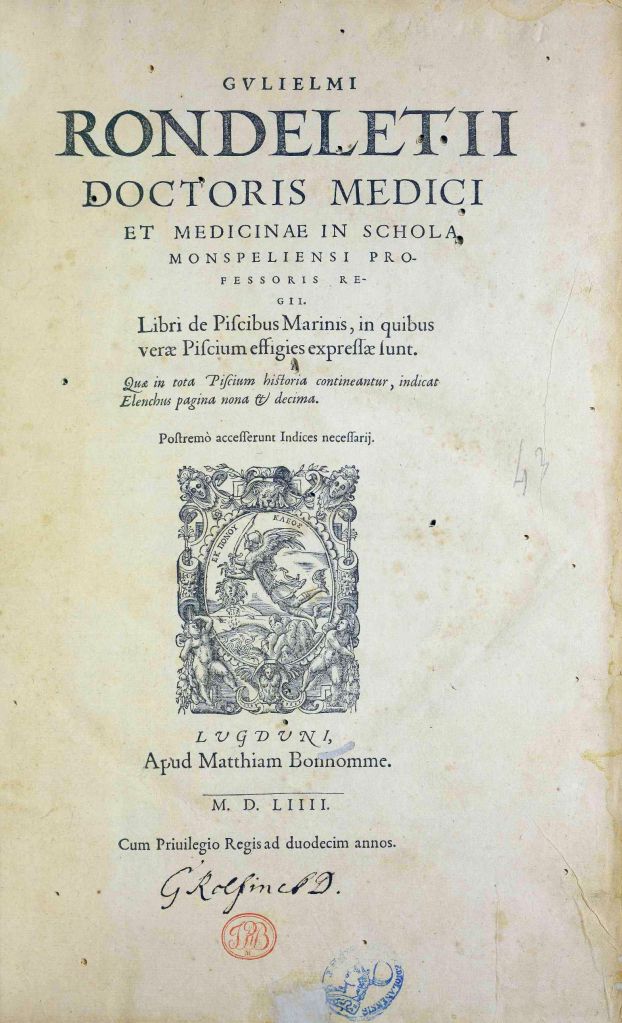
Although the title refers to fish (piscibus), the book actually deals with all aquatic animals. Rondelet makes no distinction between fish, marine animals such as seals and whales, crustaceans, and other invertebrates. He investigated the difference between fresh water and saltwater fish. His approach was Aristotelean emphasising function. He dissected and illustrated many of his specimens and his anatomical drawings off a sea urchin is the earliest know drawing of an invertebrate. He made anatomical comparisons and found similarities between dolphins, pigs, and humans. The book became a standard reference work for many years and was translated into French in 1558 as L’histoire entière des poissons (The complete history of fish).
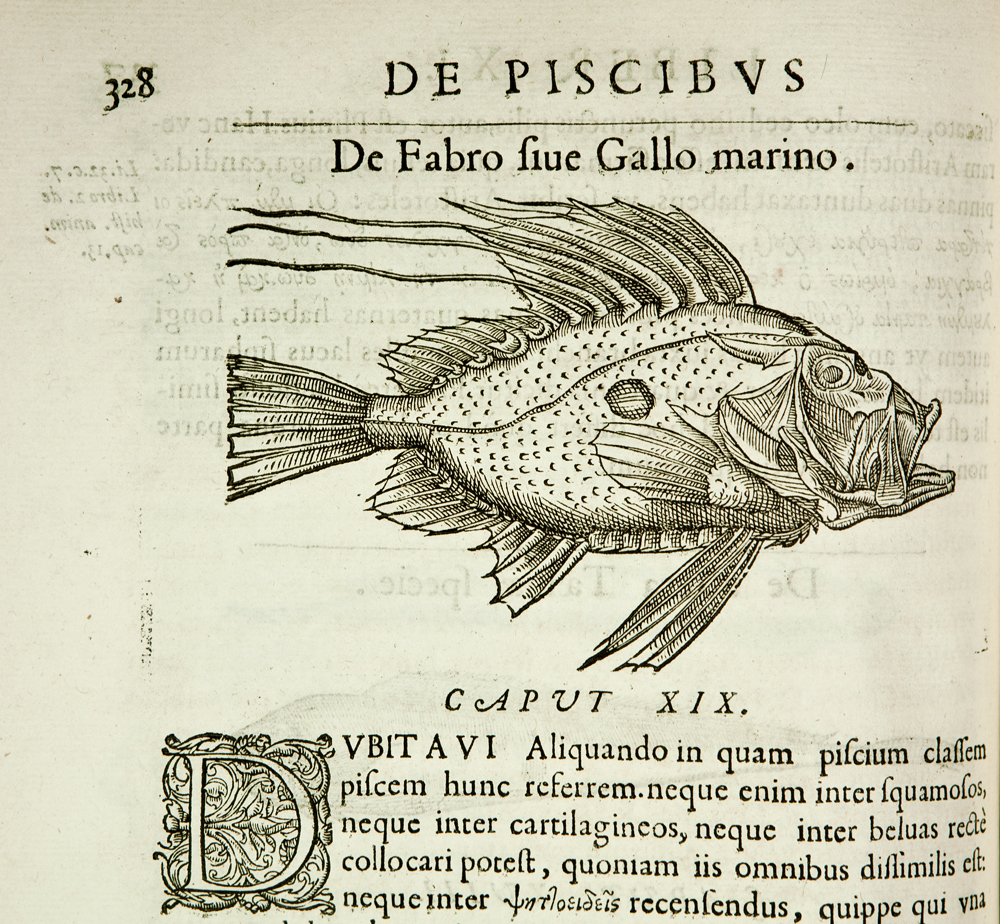
Without doubt the most influential text on the road to the discipline of zoology published in the sixteenth century was the more than four-thousand-and-five-hundred-page, five-volume Historia animalia issued by the Swiss polymath Conrad Gessner (1516–1565) between 1551–1558 and 1587 posthumously in Zurich.
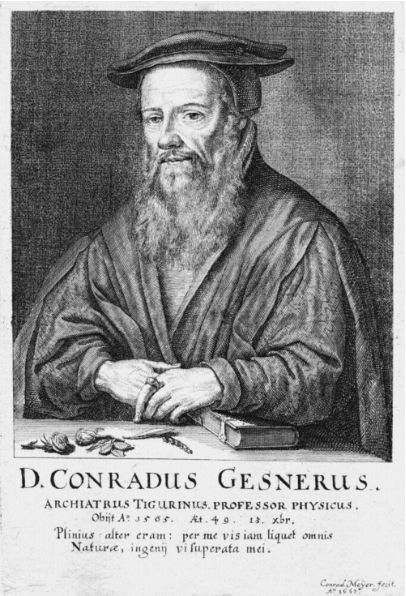
I have written about Gessner in the past, but the short version is, he was the polymath’s polymath. A humanist, encyclopaedist, philologist, bibliographer, zoologist, botanist, alpinist, linguist, and professional physician. He was not only an encyclopaedist but a completist. His Bibliotheca universalis (1554–) was an attempt to list alphabetically all of the books printed and published in Latin, Greek, and Hebrew since the invention of printing with movable type. He followed this with a thematic index to the Bibliotheca universalis, the Pandectarum sive Partitionum universalium Conradi Gesneri Tigurini, medici & philosophiae professoris, libri xxi with thirty thousand entries in 1548.
His approach to the Historia animalia was the same, it was an attempt to provide descriptions of all known animals. The animals were listed alphabetically but divided up in divisions in the style of Aristotle. Volume I Quadrupedes vivipares. 1551 (Live-bearing four-footed animals), Volume II Quadrupedes ovipares. 1554 (Egg-laying quadrupeds, reptiles and amphibia), Volume III Avium natura. (Birds) 1555, Volume IV Piscium & aquatilium animantium natura 1558 (Fish and aquatic animals), Volume V De serpentium natura (Snakes and scorpions).
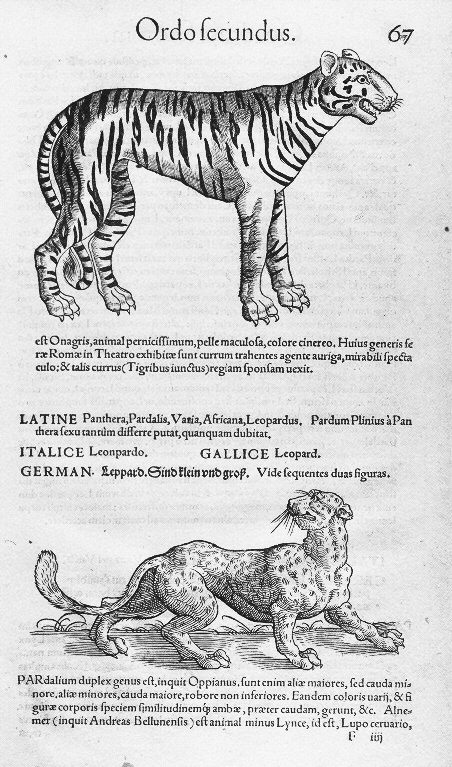
In 1638 a further volume on insects was published from his Nachlass. To write his book, Gessner drew on multiple sources giving credit to their authors. As well as an illustration of each animal, here he famously used Dürer’s rhinoceros, he included vast amounts of information–the animal’s name in all the languages know to him, habitat, description, physiology, diseases, habits, utility, diet, curiosities, all crossed referenced to ancient and modern authorities. Gessner, in has attempt at completeness, also included some mythical creatures, in some cases stating that he didn’t know if they existed or not.
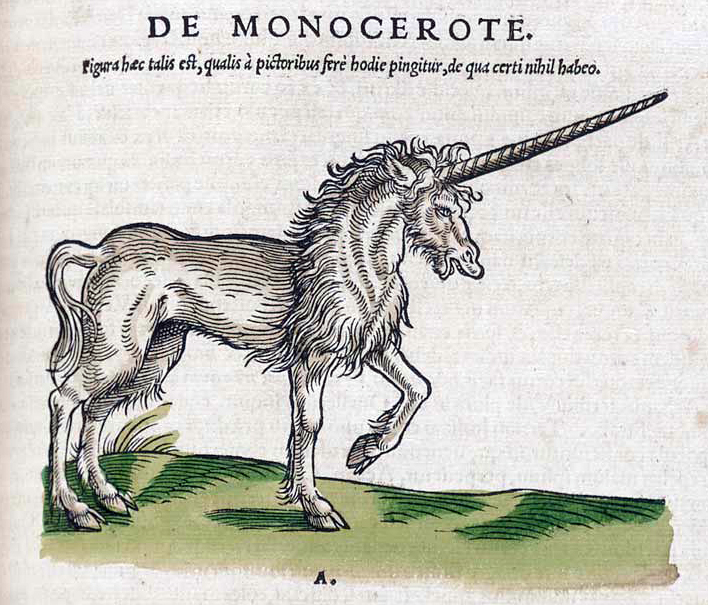
The Historia animalia was immensely successful and an abbreviated version, the Thierbuch, appeared in German in 1565.
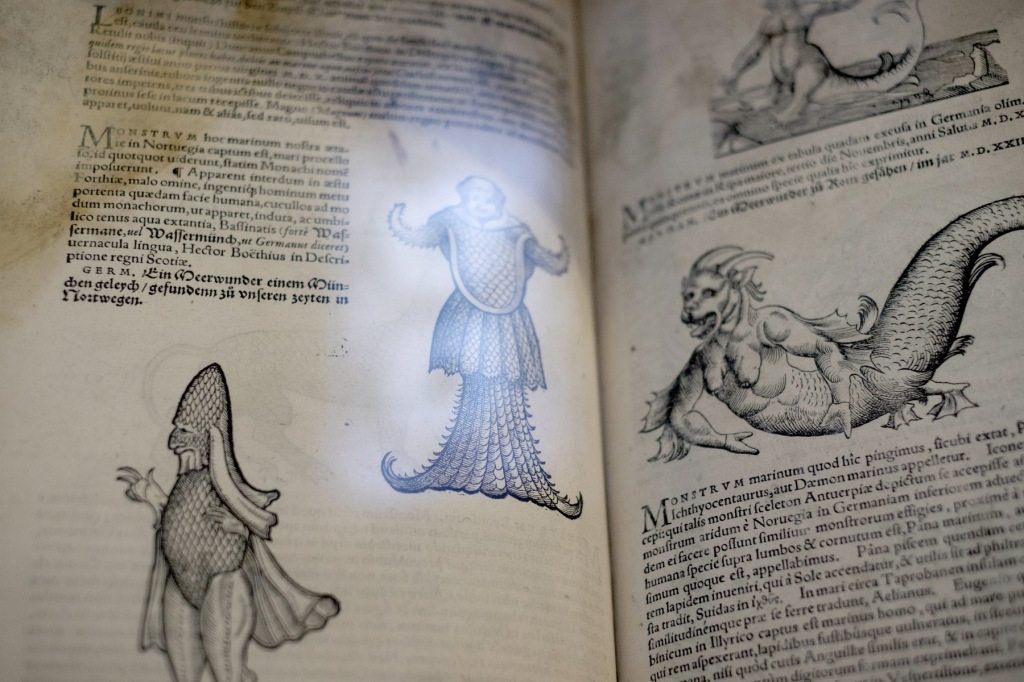
Just as encyclopaedic as Gessner’s work were the volumes on animals put together by the Italian natural historian Ulisse Aldrovandi (1522–1605), whose five hundredth birthday we will be celebrating on 11 September.
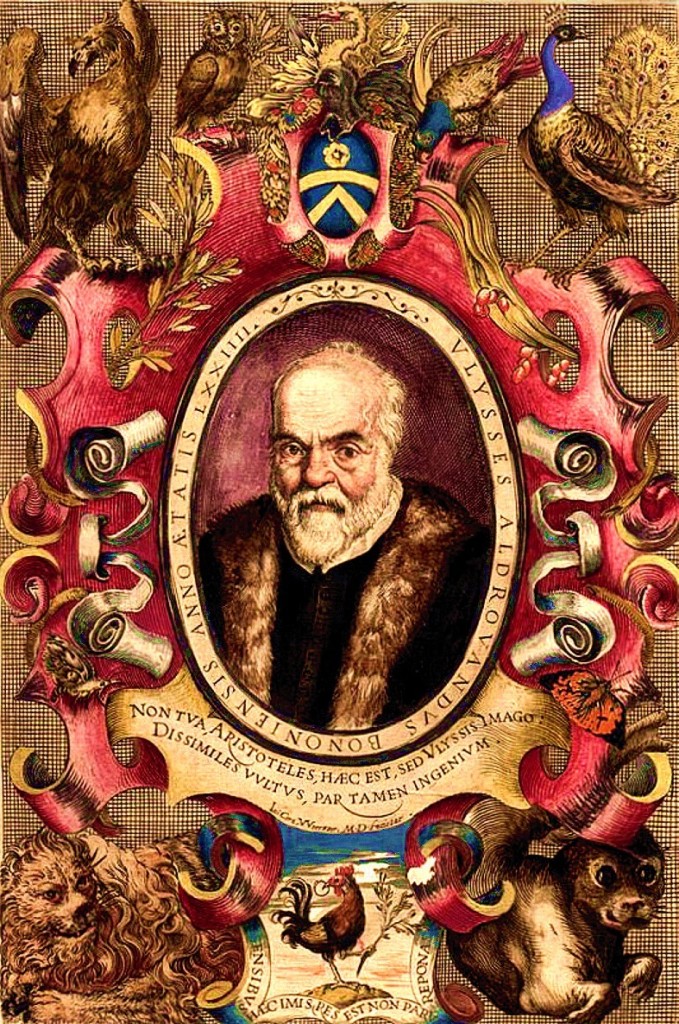
He was born in Bologna into a noble family, a nephew of Pope Gregory XII. He father, a lawyer, died when he was seven. In his youth he studied first mathematics and then Latin under prominent private tutors. Following his mother’s wish he studied law but shortly before graduating he switched to philosophy. To complete his philosophy studies, he switched to the University of Padua, where he began to study medicine in 1545. In 1549 he was accused of heresy and had to go to Rome to clear his name. In 1550, he met Guillaume Rondelet, whom he accompanied on his visits to the local fish markets to study fish, which awakened Aldrovandi’s interest in zoology. Returning to Bologna he met Luca Ghini (1490–1556), who played such a central role in the early study of plants, and this awakened his interest in botany. When Ghini returned to Pisa, Aldrovandi followed him to attend his lectures on medical simples. In 1552 he graduated in philosophy at Bologna and a year later in medicine. In 1554 he was appointed lecturer for logic at the university and in 1559 professor for philosophy.
In 1561 he became the first professor of natural history at Bologna, Lectura philosophiae naturalis ordinaria de fossilibus, plantis et animalibus. Aldrovandi devoted the rest of his life to the study and propagation of natural history. He set up the university botanical garden in 1568 and a museum for natural history, which I will look at more closely in a later post. Like Gessner, he spent years collecting material for a Historia Animalia, but didn’t start writing it until he was seventy-seven-years-old. He only managed to publish three of the eventual eleven volumes before he died aged eighty-two. The other eight volumes were published posthumously by Johannes Cornelius Uterverius (1592–1619), Thomas Dempster (1579–1625), and Bartholomäus Ambrosinus. Ornithologiae, hoc est, de avibus historiae libri XII. Agent de avibus rapacibus (1600);
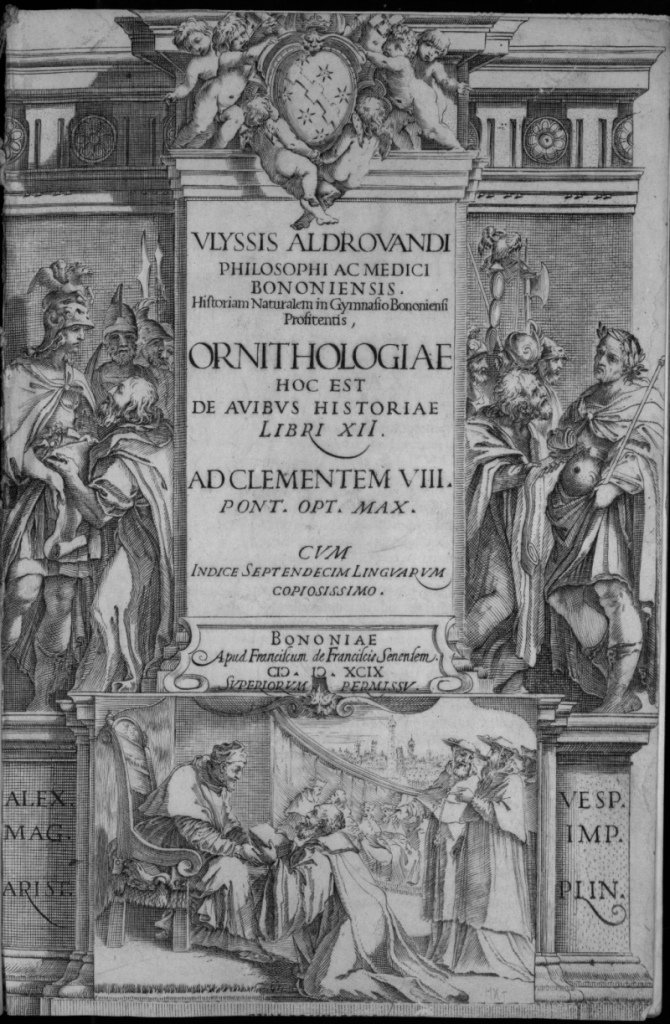
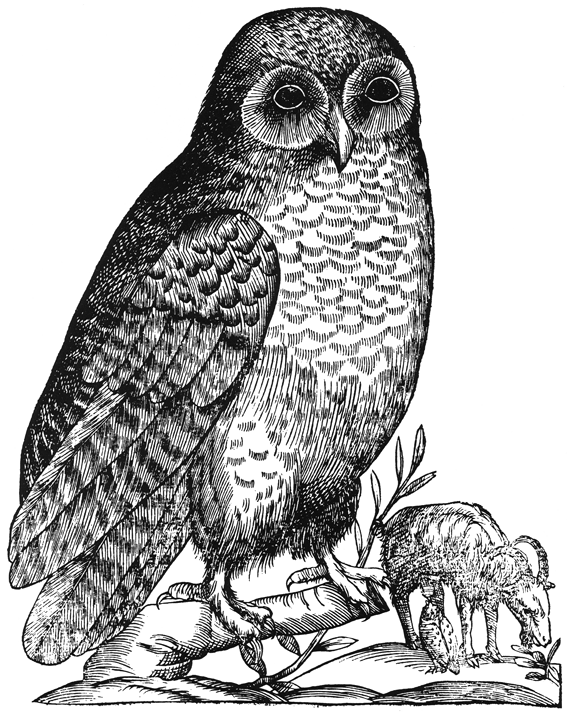
Ornithologiae tomus alter de avibus terrestribus, mensae inservientibus et canoris (1600); De aninialibus insectis libri VII (1602);
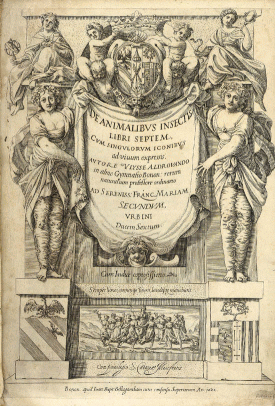
Ornithologiae tomus tertius ei ultimus de avibus aquaticis et circa quas degentibus (1603); De reliquis animalibus exanguibus, utpote de mollibus, crustaceis, testaceis et zoophytis, libri IV (1606); Quadrupedum omnium bisulcorum historia (1613);
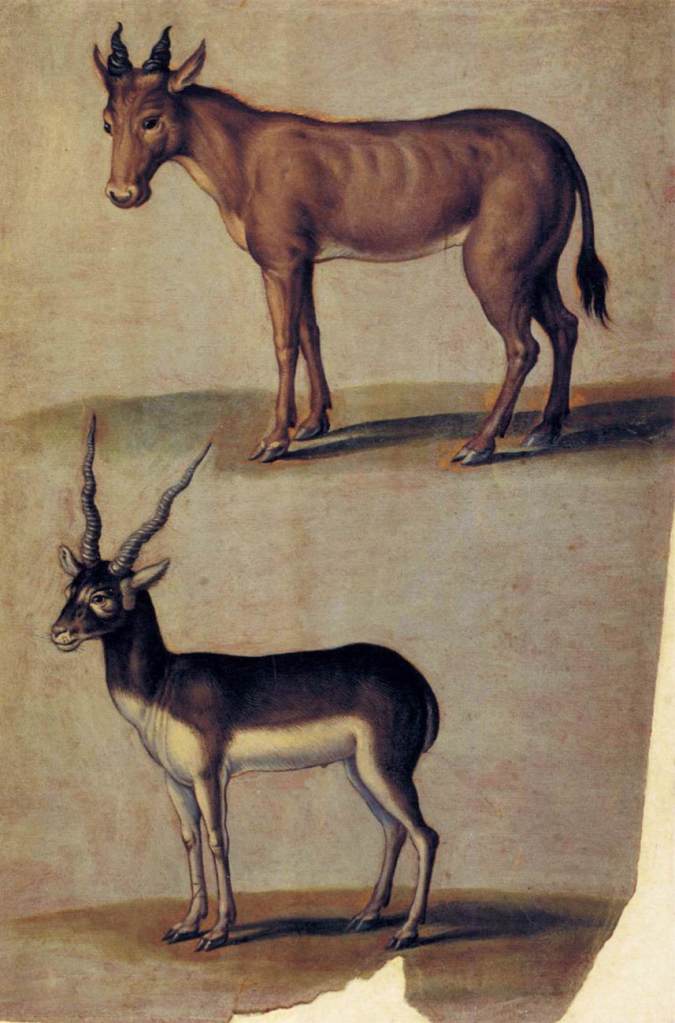
De piscibus libri V et de cetis liber unus (1613); De quadrupedibus digitatis viviparis libri III, et de quadrupedibus oviparis libri II(1637); Historiae serpentum et draconum libri duo (1640);
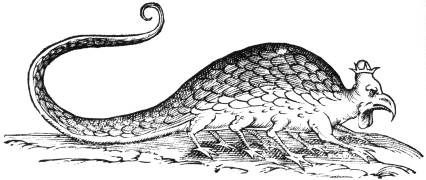
Monstruorum historia(1642)
 100vw, 636px”></a><figcaption>Harpy. Ulisse Aldrovandi, <em>Monstrorum historia</em>, Bologna, 1642. Source: Wikimedia Commons</figcaption></figure>
<p>There were also some smaller individual studies published in the sixteenth century. The Cambridge scholar and physician John Caius (1510–1573) </p>
<figure class=)
 School; John Caius, Master (1559-1573); Gonville & Caius College, University of Cambridge; http://www.artuk.org/artworks/john-caius-master-15591573-233190</p>
<p> ” data-medium-file=”https://wolfscientific.com/wp-content/uploads/2022/06/renaissance-science-xxxvii-115.jpg” data-large-file=”https://wolfscientific.com/wp-content/uploads/2022/06/renaissance-science-xxxvii-117.jpg?w=500″ src=”https://wolfscientific.com/wp-content/uploads/2022/06/renaissance-science-xxxvii-23.jpg” alt class=”wp-image-9110″ srcset=”https://wolfscientific.com/wp-content/uploads/2022/06/renaissance-science-xxxvii-23.jpg 785w, https://wolfscientific.com/wp-content/uploads/2022/06/renaissance-science-xxxvii-114.jpg 115w, https://wolfscientific.com/wp-content/uploads/2022/06/renaissance-science-xxxvii-115.jpg 230w, https://wolfscientific.com/wp-content/uploads/2022/06/renaissance-science-xxxvii-116.jpg 768w, https://wolfscientific.com/wp-content/uploads/2022/06/renaissance-science-xxxvii-117.jpg 920w” sizes=”(max-width: 785px) 100vw, 785px”></a><figcaption> John Caius, Master (1559-1573); Gonville & Caius College, University of Cambridge; artist unknown Source: Wikimedia Commons</figcaption></figure>
<p>was a correspondent of Gessner’s and produced a study of British dogs for him, which Gessner didn’t publish, so he published it himself in 1570, <em>De Canibus Britannicis</em>. </p>
<figure class=)
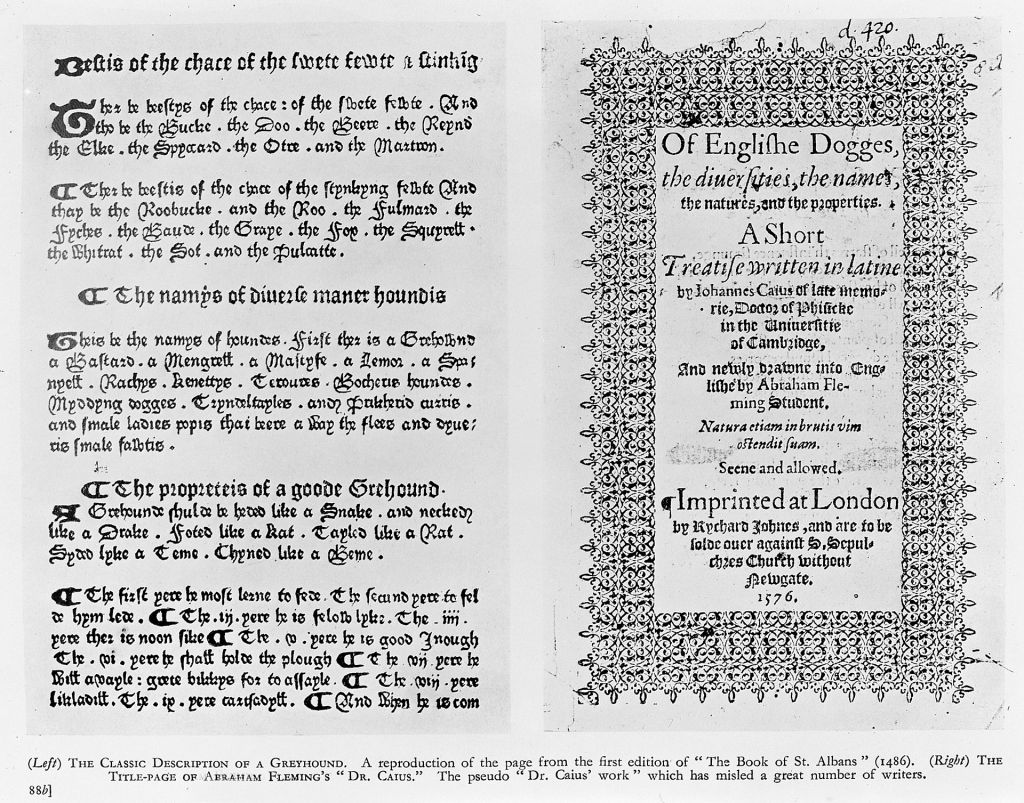
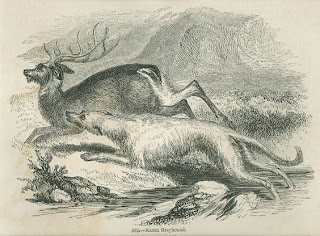
In the same year he also published De Rariorum animalium atque stirpium historia, libellus (Of Some Rare Plants and Animals).
The Bologna senator, Carlo Ruini (1530–1598) wrote a very accurate and comprehensive Anatomia del cavallo, infermità, et suoi rimedii (On the Anatomy and Diseases of the Horse), which was published posthumously in Venice, in 1598.
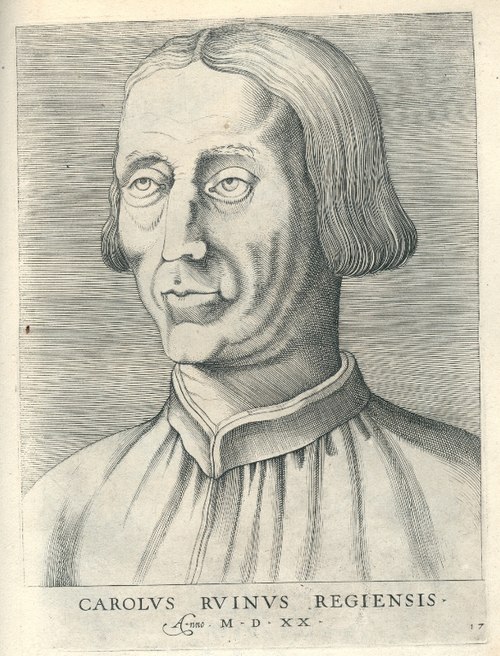
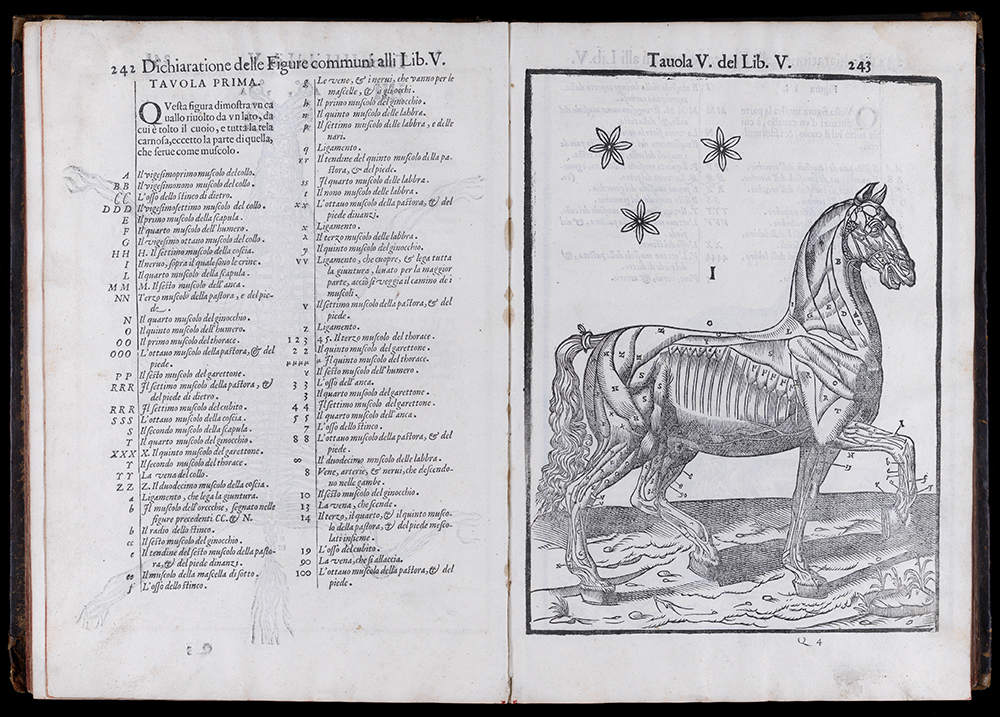
Finally, the English student of Felix Platter, Thomas Moffet (1533–1604) compiled the Insectorum sive Minimorum Animalium Theatrum (Theatre of Insects) based on his own work and that of Gessner, Edward Wotten (1492–1555) and the physician Thomas Perry (1532–1589).
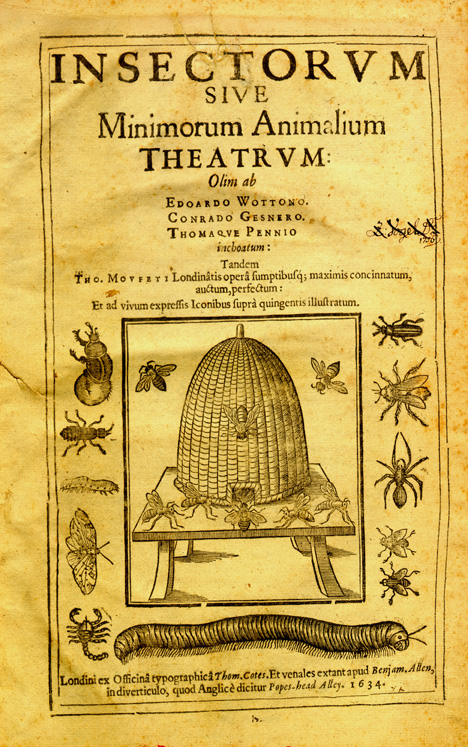
Edward Wotten, a graduate of Padua, had earlier published his Aristotelian research on animals De differentiis animalium libri decem, in Paris in 1552.
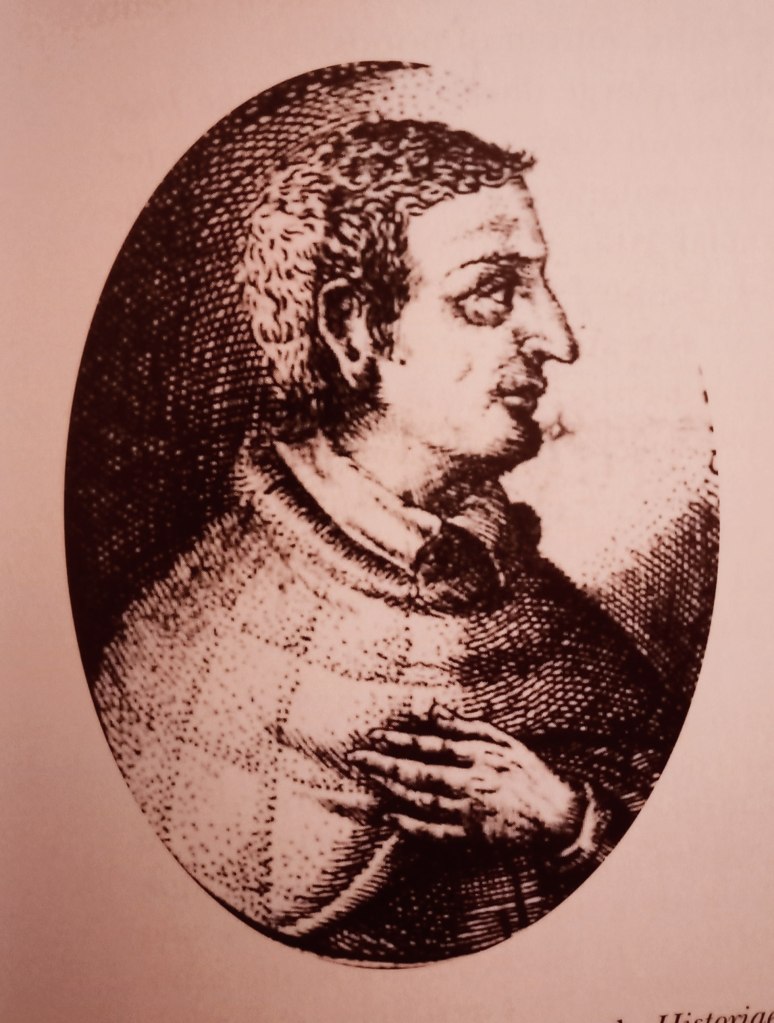
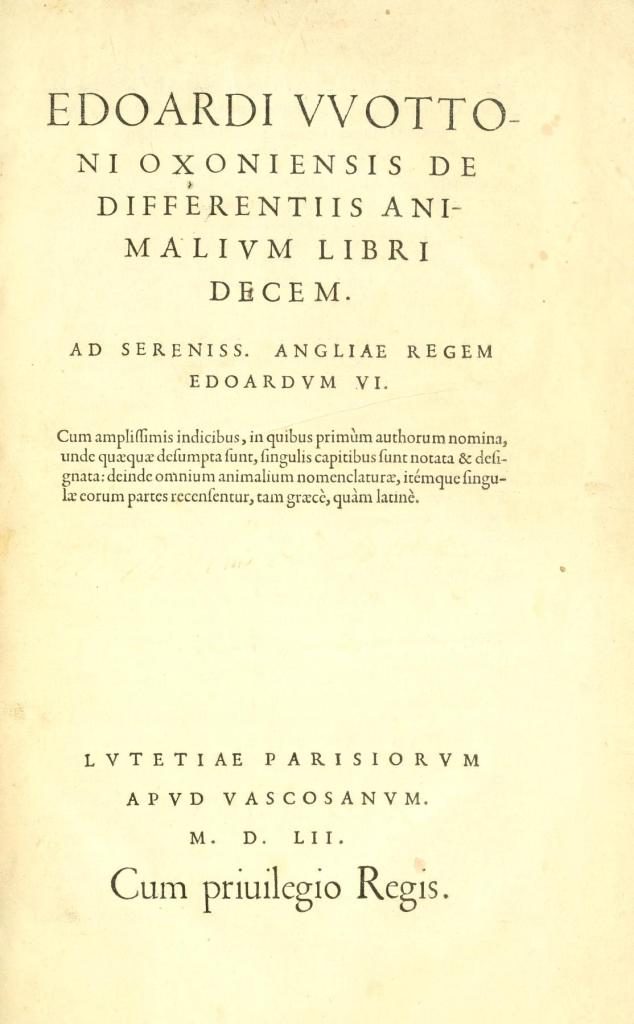
Although the developments in zoology in the sixteenth century were not as widespread or as progressive as those in botany as we have seen they were not insubstantial and laid foundations that were developed further in the late seventeenth and eighteenth centuries.
[1] For details of that dispute see Episode XXXII of this series
[2] For more on Valerius Cordus see Episode XXXV of this series